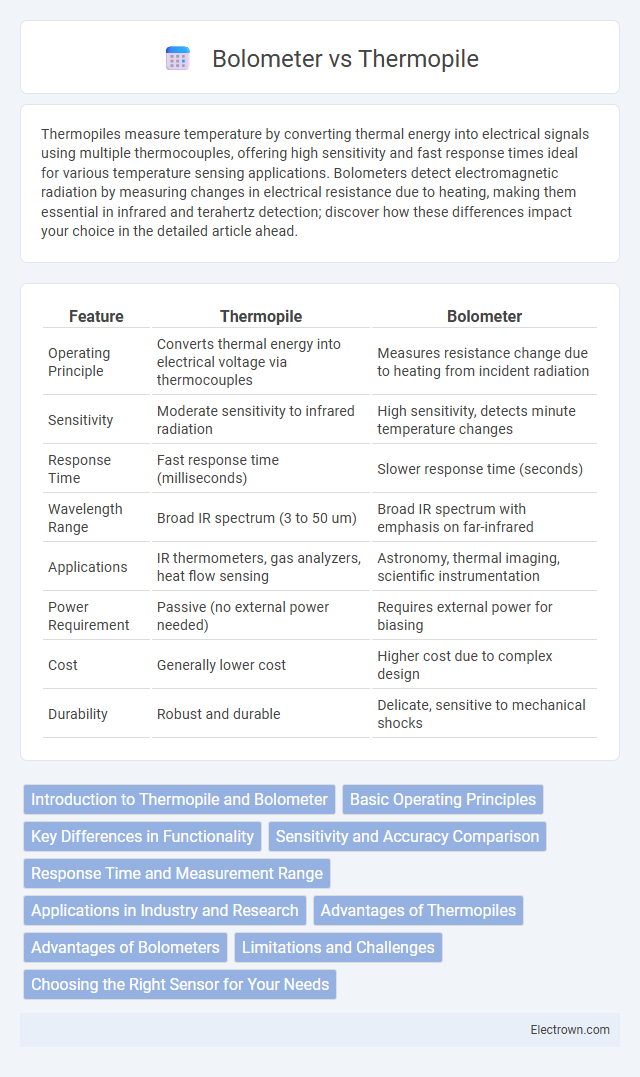Thermopiles measure temperature by converting thermal energy into electrical signals using multiple thermocouples, offering high sensitivity and fast response times ideal for various temperature sensing applications. Bolometers detect electromagnetic radiation by measuring changes in electrical resistance due to heating, making them essential in infrared and terahertz detection; discover how these differences impact your choice in the detailed article ahead.
Table of Comparison
| Feature | Thermopile | Bolometer |
|---|---|---|
| Operating Principle | Converts thermal energy into electrical voltage via thermocouples | Measures resistance change due to heating from incident radiation |
| Sensitivity | Moderate sensitivity to infrared radiation | High sensitivity, detects minute temperature changes |
| Response Time | Fast response time (milliseconds) | Slower response time (seconds) |
| Wavelength Range | Broad IR spectrum (3 to 50 um) | Broad IR spectrum with emphasis on far-infrared |
| Applications | IR thermometers, gas analyzers, heat flow sensing | Astronomy, thermal imaging, scientific instrumentation |
| Power Requirement | Passive (no external power needed) | Requires external power for biasing |
| Cost | Generally lower cost | Higher cost due to complex design |
| Durability | Robust and durable | Delicate, sensitive to mechanical shocks |
Introduction to Thermopile and Bolometer
Thermopiles are sensors that convert thermal energy into electrical voltage by combining multiple thermocouples, making them ideal for precise temperature measurement and infrared detection. Bolometers measure the power of incident electromagnetic radiation through the change in electrical resistance caused by heating, commonly used in astronomy and thermal imaging. Your choice depends on specific application requirements such as sensitivity, response time, and spectral range.
Basic Operating Principles
Thermopiles generate voltage based on the Seebeck effect by converting thermal energy differences into electrical signals through a series of thermocouples. Bolometers measure incident electromagnetic radiation by detecting changes in electrical resistance caused by temperature variations in a thermistor material. Both devices are widely used in infrared detection, but thermopiles rely on voltage generation, while bolometers depend on resistance change for temperature measurement.
Key Differences in Functionality
Thermopiles generate electrical voltage by converting thermal energy through multiple thermocouples, enabling precise temperature measurement without external power. Bolometers detect radiation by measuring changes in electrical resistance caused by temperature variations in an absorbing material, often requiring cryogenic cooling for enhanced sensitivity. The fundamental difference lies in thermopiles producing a direct voltage signal from temperature gradients, while bolometers rely on resistance changes to quantify incident radiation intensity.
Sensitivity and Accuracy Comparison
Thermopiles generally offer higher sensitivity compared to bolometers due to their ability to convert thermal energy directly into electrical signals with minimal noise interference. Bolometers excel in accuracy for measuring minute temperature changes because they rely on resistance variations precisely correlated to temperature fluctuations, making them ideal for ultra-fine thermal detection. When choosing between the two, your application's need for either enhanced sensitivity or superior accuracy will determine the optimal sensor type.
Response Time and Measurement Range
Thermopiles typically exhibit slower response times ranging from tens to hundreds of milliseconds, making them suitable for steady-state or slow-changing temperature measurements, while bolometers offer faster response times often in the microsecond to millisecond range, enabling detection of rapid thermal fluctuations. In terms of measurement range, thermopiles function effectively across a broad temperature spectrum, from near ambient up to several hundred degrees Celsius, whereas bolometers are highly sensitive to small temperature changes within narrower ranges, often optimized for infrared radiation detection. These characteristics make thermopiles ideal for applications requiring robust, long-term monitoring, whereas bolometers excel in precision measurements where temporal resolution is critical.
Applications in Industry and Research
Thermopiles are extensively used in industrial temperature measurement and automation systems due to their robustness and fast response in detecting infrared radiation. Bolometers find critical applications in astronomical research and material analysis, providing highly sensitive detection of electromagnetic radiation across various wavelengths. Both sensors play vital roles in thermal imaging, environmental monitoring, and scientific instrumentation, with thermopiles favored for rugged industrial environments and bolometers for precision research measurements.
Advantages of Thermopiles
Thermopiles offer faster response times and higher sensitivity compared to bolometers, making them ideal for precise infrared temperature measurements. Their robust construction allows operation over a wide temperature range without significant drift, enhancing durability in industrial applications. Thermopiles also provide self-powered voltage output, reducing the need for external power sources and improving overall energy efficiency.
Advantages of Bolometers
Bolometers offer superior sensitivity to low levels of infrared radiation due to their high thermal response, making them ideal for precise temperature measurements. Their ability to detect a broader spectral range enhances the accuracy of thermal imaging and spectroscopy applications. Your projects benefit from bolometers' improved signal-to-noise ratio and stable performance in varying environmental conditions.
Limitations and Challenges
Thermopiles face limitations such as slower response times and lower sensitivity compared to bolometers, which hinders their effectiveness in detecting rapid temperature changes. Bolometers, while highly sensitive to minute temperature variations, suffer from complex fabrication processes and susceptibility to noise and environmental interference. Both sensors require careful temperature calibration and are challenged by material stability and long-term reliability issues in harsh operating conditions.
Choosing the Right Sensor for Your Needs
Thermopile sensors offer fast response times and are ideal for measuring moderate temperature ranges without direct contact, making them suitable for non-invasive applications such as infrared thermometers and gas analysis. Bolometers provide higher sensitivity and precision in detecting minute temperature changes, often used in scientific research and thermal imaging where detecting low infrared radiation levels is critical. Selecting the right sensor depends on factors like required sensitivity, response speed, operating temperature range, and intended application environment.
Thermopile vs Bolometer Infographic

 electrown.com
electrown.com